Michael Sandford is an experienced SEO but, after time, he got tired of using his skills to build successful businesses for others.
He decided he wanted to run his own e-commerce business.
A series of chance encounters led to his acquisition of an existing business in 2021: Big Whistle. The online store sells Irish tin whistles, and although it may seem like a small, obscure niche to some, Michael saw its potential.
In just a few short years, he and his partner have been able to grow revenue by over 450% from where they started, earning over $25k per month at the moment.
Keep reading to find out:
- How Michael found out about the business
- The story behind Big Whistle
- The business Michael ran before Big Whistle
- How much he’s earning
- How much traffic the store gets
- His main marketing strategies
- His thoughts on SEO
- His approach to keywords and content
- His thoughts on link building
- His go-to resources and tools
- His main challenge
- His greatest accomplishment
- His biggest mistake
- His advice for other entrepreneurs
Meet Michael Sandford
Hi, I’m Michael! I’m based in the UK. I currently work with an SEO agency most days, and work on my musical instruments e-commerce site, Big Whistle, on the side. I’ve always been heavily involved in music, and I also own and run a music blog, although that’s on hold right now.
Why He Created His Site
Big Whistle has a somewhat unique story.
I didn’t actually create Big Whistle; it’s a business that was started by someone else over twenty years ago, and I acquired it in partnership with two friends of mine.
The site is an e-commerce site that specializes in Irish tin whistles and low D whistles – in other words, it’s a specialist musical instrument shop.
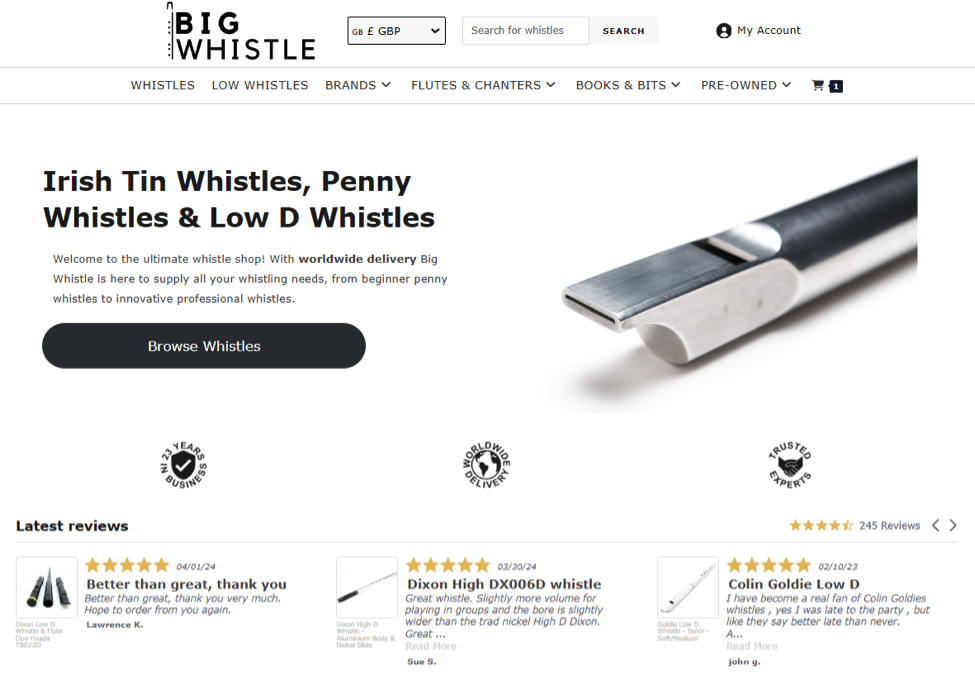
A series of serendipitous events led to the acquisition.
My friend David, who I co-own the business with, is the key connection. He acquired a tin whistle manufacturing business a few years ago, and I helped him with his website and marketing, back in 2018.
After the SEO work I did on his site, I saw sales take off for him. He was really pleased, and so was I.
But, I was also a little frustrated.
I did SEO on other people’s sites every day, often seeing them grow massively. I told David that although I was pleased about his success, I was frustrated that other people kept reaping the fruits of my labor. I told him that I was interested in building my own e-commerce site.
“It’s funny you should say that,” David responded, “because I had a conversation with someone in the tin whistle space who is looking to sell his site.”
Big Whistle was a true passion project for its previous owner, Phil, and he built a fantastic reputation through the website, and through a music festival that he ran under the same brand.
David met Phil at the festival, where Phil took a shine to David, and where Phil mentioned selling the site.


I immediately started looking into the site and I got a sense for its potential.
The domain was 20 years old, with a small handful of really powerful links. The site also had one or two good rankings, and I could see the potential to rank for lots more relevant keywords.
The conversation with the site’s owner started in early 2021 during the lockdown. By the summer that year, we completed the deal and took over the site.
To many people I speak with, Big Whistle sounds like an obscure business that surely wouldn’t have many customers or turn a profit. But Niche Pursuit readers know well that serving a small niche is a fantastic way to build a business. It’s wonderful selling to a community that gets so much enjoyment from the products we sell.
As I mentioned earlier, Big Whistle isn’t the only website I own.
Before acquiring Big Whistle, I started the blog Pink Wafer, which also has quite an unusual story.
I started Pink Wafer as a music events brand, in conjunction with the blog. I ran events every month and interviewed artists on the blog.
In 2020, I launched a physical magazine. Crazy, I know!
I used a traditional paid advertising model, getting advertisers to buy space in the magazine, and I distributed the magazine for free. The magazine was launched literally the weekend before the UK went into lockdown.
Naturally, it was a real shock when the lockdown hit.
I printed and distributed nearly 15,000 magazines. Most of these copies simply sat in bars and venues across the north of England, unread for weeks, while these places were locked down.


The world and people’s lives changed significantly, and by the time these physical venues started opening again, I suspect that the owners had thrown most of the magazines out.
Strangely, although I was working in the SEO industry every day, it took me several more months until I really started trying to get serious traffic to my blog. For whatever reason, I had just been so focused on the idea of a print publication.
Eventually, I found out that an SEO colleague of mine had a music blog that was getting good traffic, and that really spurred me on. Thanks to the brand I had built through events and the magazine, I already knew a few good writers, and that helped me to grow the site.
I got the site to nearly 90,000 monthly sessions, generating about $1.6k/month when Google’s “Helpful Content Update” hit.


With Pink Wafer, I had a real life brand, with passionate writers who knew their stuff and high editorial standards, so it was pretty disheartening to see Google decide that it didn’t like my site anymore.
Fortunately for me, I also had Big Whistle up and running by this point. So while it was painful to see my blog crumble overnight, the experience didn’t ruin my life as it did for some bloggers!
I posted my traffic decline in the Mediavine bloggers Facebook community, which got a very lively discussion going.
Jared and Spencer actually mentioned the Facebook discussion on the Niche Pursuits podcast, so as an avid follower of the show, that was a “silver lining” for me!
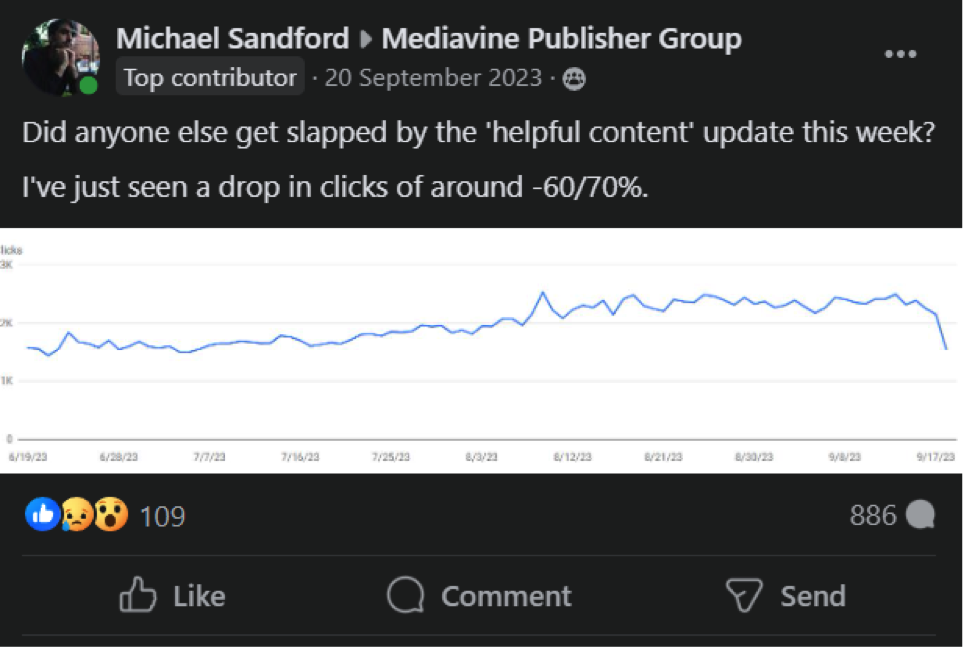

How Much He’s Earning
One surprising lesson I’ve learned in the world of e-commerce is that you can turn over a lot of cash without necessarily making huge profits.
The first reason for this is because when you work with suppliers, the mark-up is not always high. On average, the mark-up might be around 30-40%.
And out of that, we then have to cover various overheads. Overheads include labor costs to actually pack and ship products, rent for storage space, packaging materials, insurance, accounting fees, hosting and plugins, currency conversion, payment gateway fees, and all kinds of other minor costs that add up. Then after all that, there’s tax. So you can imagine how profit gets eaten away!
This being said we’ve managed to grow revenue by over 450% from where we started.
Today, we generally take over $25k/month in revenue. By comparison, in our first month, we took about $3k/month.
Our first full trading month was July 2021, and our first $25k/month was May 2023, just under two years later.
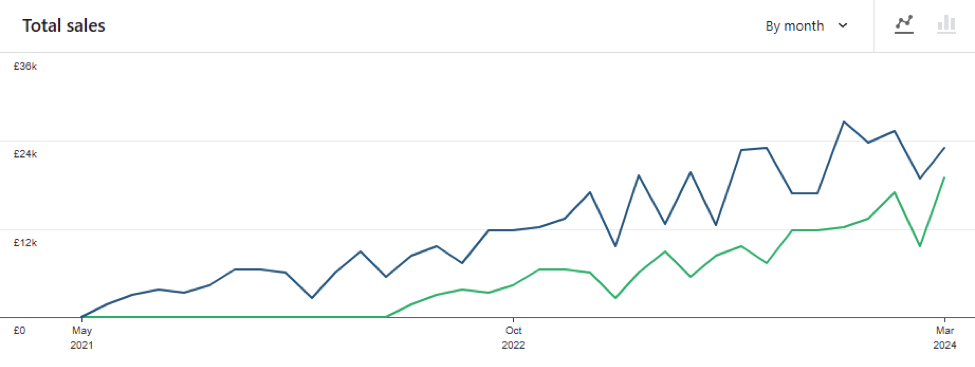

As I mentioned above, my co-owner, David, manufactures his own whistles. In the world of manufacturing, mark-ups are much bigger.
We started a new manufacturing brand about a year and a half ago, which we sell through Big Whistle, and that adds a nice extra revenue stream for us.
Generally speaking, we are still reinvesting as much as possible, so between the two operations, profits work out around $7k/month.
As a digital marketing and SEO guy, the world of manufacturing was always a bit scary to me. I probably wouldn’t have gotten into it if it weren’t for David easing me in.
It’s not my specialism, so I won’t go into detail here, but I will say that manufacturing certainly opens doors if you can find a way into it.
The site gets between 6-7k users per month. About 50% of this, on average, is from organic search.
I’m pleased to say that around 20% is direct traffic, which I feel is a good indication of people knowing and trusting our brand.
As a general rule, I work around 5 to 15 hours per week. My most regular commitment is on the manufacturing side, which requires about 3 hours per week from me.
Recently, I’ve been spending at least a couple of hours per week on link acquisition. I may spend an hour a week keeping on top of technical tasks, or product page updates, and I’ll also typically spend an hour or so doing market and competitor research and analysis.
Going forward, I hope to carve out more time for social media and video, to help build out those channels.
Michael’s Top Marketing Strategy
One thing that has been hugely valuable for us is working with influencers.
Influencer marketing can get a bad rep in some niches, but we’ve found it to be a fantastic experience and it’s enabled us to work with some truly lovely, genuine people.
In the musical instrument niche, you get a lot of people who really love their gear. They want to learn and hear all about it; they may spend weeks or months thinking about a new product, saving up for it, and getting excited to buy it.
A number of influencers in the space regularly make videos about new products, and we have struck up relationships with these folks. These partnerships are simply fantastic.
We send them products, and they provide honest reviews. This gives them content for their channel and builds our relationship with both the influencer and their audience.
It’s been a real winner for us, and we are so grateful to the fantastic influencers we work with.
So far, we’ve found that simply reaching out to influencers cold has worked perfectly well.
Everyone we’ve ever messaged has responded positively, and they’ve all seemed more than happy to receive sample products from us. We’ve always made it very clear to them that they are not obliged to share anything, positive or negative.
I think that a lack of any pressure or expectation goes a long way in building these relationships.


His Thoughts on SEO
SEO is foundational for our business, with organic search accounting for around half of our revenue.
After initially acquiring the site, I did a lot of work to get a good site structure in place, creating a bunch of new, optimized category pages. After getting that in place, I didn’t do much in terms of SEO for a few months. The site was growing, and other marketing channels seemed more important.
However, in recent weeks, I realized that building our link profile could probably help us quite significantly. That is now my main focus, at least for the time being.
Keyword Research
My focus is primarily on commercial keywords.
There are opportunities out there to publish informational content, and I do work on these from time-to-time. But as an e-commerce site, at the end of the day, we want to sell products.
For that reason, the main part of my process is keeping an eye on emerging brands who we can add to our inventory. The search volumes are usually quite low for these brand terms, but we don’t mind that.
We ultimately want to stock every single quality product that exists in the market so that we can provide basically everything that our community could ever want, in terms of product offering.
Link Building
Link building seems to be as important as ever.
For a while, I was relying on the site’s existing strength a little too much because it had a decent backlink profile and a nice old domain.
However, I started to notice other sites outranking us, even though our offering is superior in almost every measurable area. I couldn’t see any good reason for it, apart from backlinks, so that has set me on a fresh link building mission.
There are several strands to my approach at the moment.
Firstly, I reach out to micro-influencers with relevant websites, even if they don’t have great authority. I’m talking about really obscure websites here, but a lot of these folks are the real deal.
They may not have great SEO but they are totally authentic. They may not have a lot of readers, but their readers take them seriously.
In doing this, I’m not just thinking about SEO benefits. I know that if these bloggers genuinely like our site, then that will help with word of mouth, direct traffic, and general brand awareness.
I think those things also have knock-on benefits for SEO; as we are starting to see more and more, Google likes brands.
The second thing I do as often as I can is respond to editorial and journalist requests.
A lot of publications are interested to hear from business owners, entrepreneurs, and digital marketing experts. For these, I simply try to contribute as much value as possible, and more often than not, this leads to a nice backlink.
I think by having these two very different approaches to backlinks, I pretty much cover all bases. Some of the links aren’t that powerful, but they are highly relevant.
The journalist ones are generally not so relevant to the brand but they tend to come from high authority sites. I’m now starting to see visibility improvements since I started paying more attention to links in the past few weeks.
His Content Creation Process
I don’t create much blog content for the site at the moment. There are fewer than 10 articles on there.
I’m arguably missing a trick, to some extent, but as I mentioned earlier, I tend to focus on commercially focused keywords. There are also a couple of informational sites out there that publish really great learning resources in the niche.
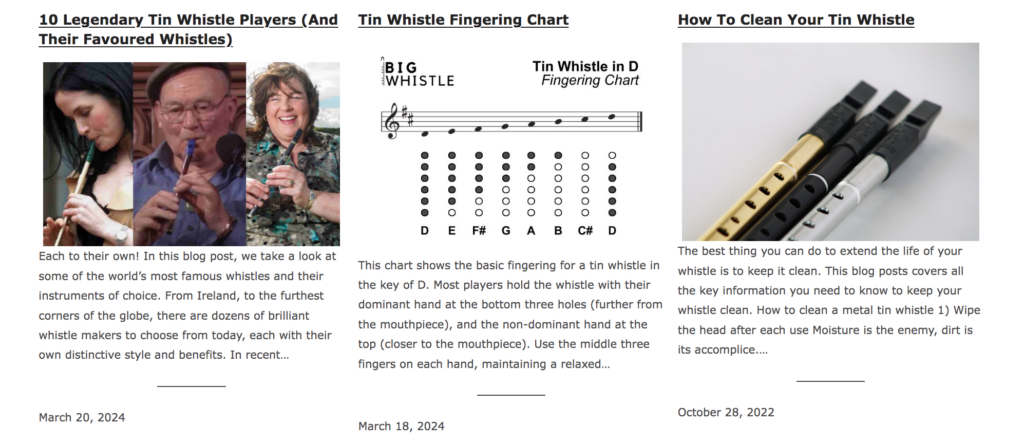

In a way, I don’t want to compete with those sites. They have their specialty and their business model and we have ours.
I’m more interested in building a mutually-beneficial relationship with them than trying to compete against their content, which they are already doing a great job with.
To give an example, I’ve recently been in touch with a blog owner in the niche. We’re now talking about starting an affiliate relationship. I would rather do that than try and outrank him with content when his content is great as it is.
Michael’s Email List
We do have an email list, but email is a channel that I’ve not worked too hard on. Most customers opt into the email list, so it is steadily ticking up.
I mostly just use it for seasonal promotions and I suppose I view it as a bit of a safety net. If we do ever have issues with organic traffic, then I’ll be very glad we have our email list.
His Favorite Resources
I don’t want to sound sycophantic, but honestly, I would recommend Niche Pursuits!
I appreciate the way that Niche Pursuits has pivoted with many of the bloggers out there who are finding themselves grappling with new ways to bring traffic to their sites and looking into new business models.
Niche Pursuits and the varied guests you feature on your site and on the podcast have always been a source of inspiration for me along my journey.
I think one key thing about Niche Pursuits which makes it different to many other channels is that it’s very pragmatic.
I see so much content from SEO software providers and SEO agencies and professionals which is very idealistic and actually demonstrates a certain ignorance about what really works.
I think people who don’t run their own businesses sometimes lack discernment about what Google says versus the reality of what really works.
Niche Pursuits focuses on people’s real-life experiences rather than abstract ideas or concepts about “best practice” and what Google may or may not theoretically like.
In a similar vein, I’ve recently seen some good content from Odys, a company that buys and sells aged domains.
I think the world of aged domains is becoming an increasingly risky business from an SEO perspective.
But, generally speaking, I like that the content I’ve seen from them tends to be pragmatic rather than overly theoretical or idealistic.
I would have to go for three SEO tools.
Firstly, I use Ahrefs all the time. It’s not perfect, but I think it’s fair to say that on the link acquisition side of things, I would be pretty lost without it.
I use it primarily to check the quality of potential link prospects and to get a better understanding of competitors.
Secondly, Search Console is invaluable for understanding the organic traffic trends on my sites. Being able to see exact keywords that drive traffic and to which page is extremely valuable.
Finally, I have been appreciating SEO Monitor a lot in recent months. Its interface and features are always getting better, and I think it’s great how it now monitors and highlights how specific changes to a page may have impacted rankings.
I also like that it shows, at a glance, how search demand has changed year-on-year for the keywords you’re tracking.
His Biggest Challenge
I think shipping always has challenges.
Fortunately for me, I don’t have to deal with that side of the business too much, but things do sometimes get held up or lost when you stock and ship a lot of products.
It’s also a real shame that since Brexit, our customers in mainland Europe are now sometimes hit with extra fees.
Luckily, customers tend to be understanding when encountering these issues, which are ultimately out of our hands.
His Greatest Accomplishment
My most important accomplishment was simply taking the plunge and acquiring the business in the first place.
I saw there was something of an opportunity there—although it was hard to know exactly how big the opportunity would be—and took that risk.
Since then, being able to significantly grow the business has also been an important accomplishment. But I think that has been relatively easy in comparison to actually deciding to go ahead with it in the first place.
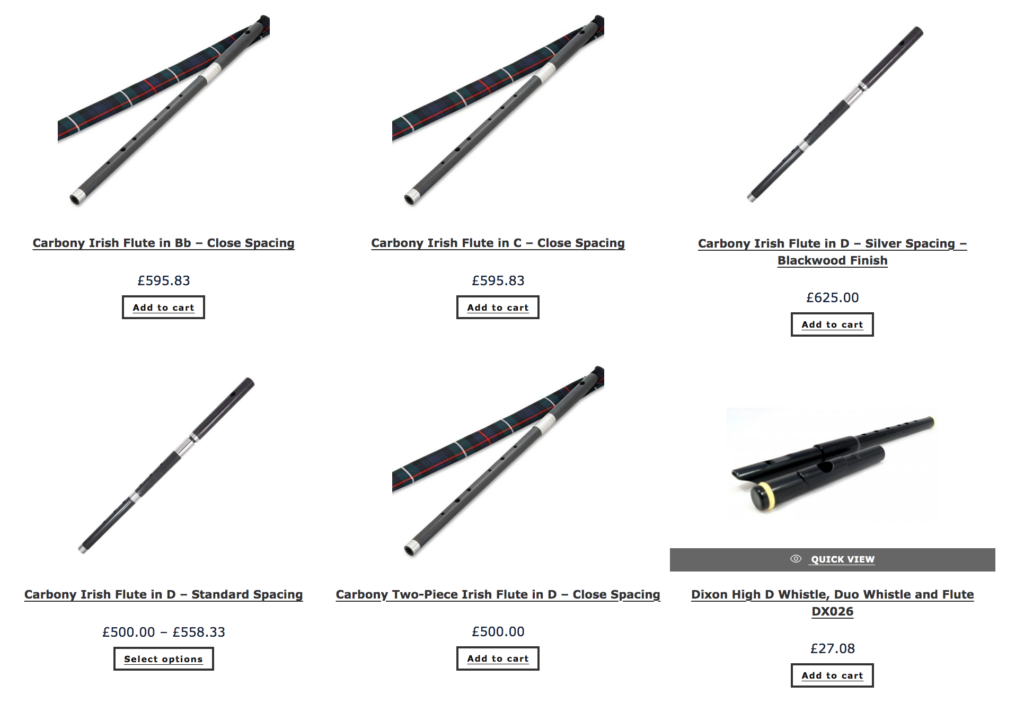

What He Wishes He Knew When He Started
I’ve started to pay a lot more attention to internationalizing the business.
From the beginning, we’ve had customers all over the world, but I definitely neglected some of the subtleties when we first started out.
We have a .co.uk domain, which I wish wasn’t the case, so I’m trying to do everything I can to make customers worldwide not feel put-off by that, or anything else.
I know that in our niche, we simply have the best offering in the world. So the aim is to remove as many barriers as possible to get people on the site, browsing our range, and shopping with us.
His Main Mistake
I’ve already alluded to this a little, but I think I have been a little complacent at times.
Because we’ve seen huge growth and had great results from organic search, I have slept on SEO a little.
SEO is my specialty, and I think the business could have grown even more if I had been more ambitious about its possibilities.
Perhaps I had in the back of my mind that we didn’t want to grow too fast. Either way, we are ready for that further growth now.
His Advice for Other Entrepreneurs
I would give the same advice that I’m also currently giving to myself, which is to give attention to diverse marketing channels.
When you see results coming from Google search and Google ads, it’s easy to sit back and enjoy it, and even take it for granted. But as the Helpful Content Update showed us, Google algorithm changes can be unkind.
Relying too heavily on one or two channels does not make for a resilient business.
For this reason, I’m planning to spend more time on social, video, email, and even face-to-face events going forward.
I would encourage other entrepreneurs who aren’t already doing this to do the same – diversify your marketing efforts!
